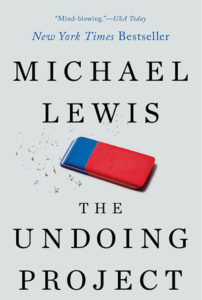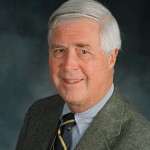 No, this is not the story of a baseball team savant, who doubted conventional statistics and reused them with extraordinary success (Moneyball). It is not a personal disclosure of the seamy underbelly of financial markets (The Big Short; Flash Boys; Liar’s Poker).
No, this is not the story of a baseball team savant, who doubted conventional statistics and reused them with extraordinary success (Moneyball). It is not a personal disclosure of the seamy underbelly of financial markets (The Big Short; Flash Boys; Liar’s Poker).
Rather, it is the story of learning how our minds work, of behavioral economics, and of the unusual and highly prolific working relationship of two Israeli academics, who first met in 1960. It is the story of how an extrovert, Amos Tversky, and an introvert, Daniel Kahneman, stimulated and prodded each other over almost 40 years, first in Israel and then teaching in the United States on the West coast, then in the Midwest, and finally in the East, uncovering and describing the numerous biases that confuse our thinking.
Each challenged the ideas of the other.
As the author describes an early intellectual collision, “Theories for Amos were like mental pockets or briefcases, places to out the ideas you wanted to keep. Until you could replace a theory with a better theory–a theory that better predicted what actually happened—you didn’t chuck a theory out. Theories ordered knowledge, and allowed for better prediction … But (Amos) left Danny’s seminar in a state of mid unusual for him: doubt. After the seminar, he treated theories that he had more or less accepted as sound and plausible as objects of suspicion.”
Kahneman: his “defining emotion is doubt.”
Tversky: his interest is psychology: “why people behaved as they behaved, and thought as they thought,” never entirely “rational.”
Kahneman: “He thought of himself as someone who enjoyed, more than most, changing his mind.”
Tversky: “People live under uncertainty whether they like it or not.”
Kahneman: “It is the anticipation of regret that affects decisions, along with the anticipation of other consequences. This is why we seem to be instinctively ‘risk averse’.”
Tversky: “Reality is a cloud of possibility, not a point.”
Kahneman: “The basic rules of undoing, however, apply alike to frustration and regret. They require a more or less plausible path leading to an alternative state.”
Together these two thinkers described the numerous biases that both confuse and enlighten our thinking: hindsight, anchoring, availability, small numbers, context, framing, the endowment effect, and many others. As Lewis explains it, “ they would learn to evaluate a decision not by its outcomes—whether it turned out to be right or wrong—but by the process that led to it. He then concludes: “ … the brain is limited. There are gaps in our attention. The mind contrives to make those gaps invisible to us. We think we know things we don’t. We think we are safe when we are not.”
In 1996, Amos Tversky died. In 2002, Daniel Kahneman won a Nobel Prize, one that almost certainly would have been awarded to Amos as well, had he been alive.
Do read this fascinating story of two thinkers, and go further and read Kahneman’s Thinking, Fast and Slow (2011). And consider my own personal haiku, one that forces me to rethink all the time:
Pause for a moment:
Doubt, then curiosity.
Try another path.
Editor’s Note: ‘The Undoing Project’ by Michael Lewis was published by W. W. Norton, New York, in 2017.
 About the Author: Felix Kloman is a sailor, rower, husband, father, grandfather, retired management consultant and, above all, a curious reader and writer. He’s explored how we as human beings and organizations respond to ever-present uncertainty in two books, ‘Mumpsimus Revisited’ (2005) and ‘The Fantods of Risk’ (2008). A 20-year resident of Lyme, he now writes book reviews, mostly of non-fiction that explores our minds, our behavior, our politics and our history. But he does throw in a novel here and there. For more than 50 years, he’s put together the 17 syllables that comprise haiku, the traditional Japanese poetry, and now serves as the self-appointed “poet laureate” of Ashlawn Farms Coffee, where he may be seen on Friday mornings. His wife, Ann, is also a writer, but of mystery novels, all of which begin in a bubbling village in midcoast Maine, strangely reminiscent of the town she and her husband visit every summer.
About the Author: Felix Kloman is a sailor, rower, husband, father, grandfather, retired management consultant and, above all, a curious reader and writer. He’s explored how we as human beings and organizations respond to ever-present uncertainty in two books, ‘Mumpsimus Revisited’ (2005) and ‘The Fantods of Risk’ (2008). A 20-year resident of Lyme, he now writes book reviews, mostly of non-fiction that explores our minds, our behavior, our politics and our history. But he does throw in a novel here and there. For more than 50 years, he’s put together the 17 syllables that comprise haiku, the traditional Japanese poetry, and now serves as the self-appointed “poet laureate” of Ashlawn Farms Coffee, where he may be seen on Friday mornings. His wife, Ann, is also a writer, but of mystery novels, all of which begin in a bubbling village in midcoast Maine, strangely reminiscent of the town she and her husband visit every summer.